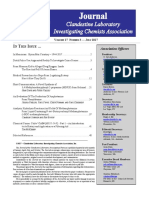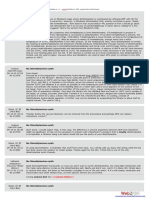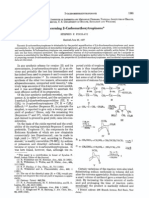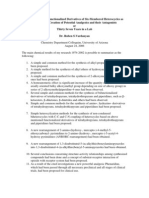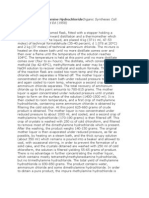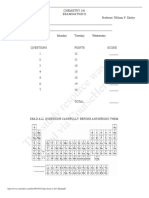Alkaloids: Alkaloids Are A Group of Naturally Occurring Chemical Compounds That Contain Mostly Basic
Alkaloids: Alkaloids Are A Group of Naturally Occurring Chemical Compounds That Contain Mostly Basic
Uploaded by
gulshan araCopyright:
Available Formats
Alkaloids: Alkaloids Are A Group of Naturally Occurring Chemical Compounds That Contain Mostly Basic
Alkaloids: Alkaloids Are A Group of Naturally Occurring Chemical Compounds That Contain Mostly Basic
Uploaded by
gulshan araOriginal Title
Copyright
Available Formats
Share this document
Did you find this document useful?
Is this content inappropriate?
Copyright:
Available Formats
Alkaloids: Alkaloids Are A Group of Naturally Occurring Chemical Compounds That Contain Mostly Basic
Alkaloids: Alkaloids Are A Group of Naturally Occurring Chemical Compounds That Contain Mostly Basic
Uploaded by
gulshan araCopyright:
Available Formats
UNIT # 03
CHAPTER # 02 ALKALOIDS
ALKALOIDS
INTRODCUTION:
DEFINITION:
Alkaloids are a group of naturally occurring chemical compounds that contain mostly basic
nitrogen atoms.
EXPLANATION:
Alkaloids include some related compounds with neutral and even weakly acidic properties. In
addition to carbon, hydrogen and nitrogen, alkaloids may also contain oxygen, sulfur and more
rarely other elements such as chlorine, bromine, and phosphorus.
Alkaloids are produced by a large variety of organisms, including bacteria, fungi, plants, and
animals, and are part of the group of natural products (also called secondary metabolites). Many
alkaloids can be purified from crude extracts by acid-base extraction. Many alkaloids are toxic to
other organisms. They often have pharmacological effects and are used as medications, as
recreational drugs, or in entheogenic rituals. Examples are the local anesthetic and stimulant
cocaine etc. Although alkaloids act on a diversity of metabolic systems in humans and other
animals, they almost uniformly invoke a bitter taste.
The boundary between alkaloids and other nitrogen-containing natural compounds is not clear-
cut. Compounds like amino acid peptides, proteins, nucleotides, nucleic acid, amines, and
antibiotics are usually not called alkaloids. Natural compounds containing nitrogen in the
exocyclic position (mescaline, serotonin, dopamine, etc.) are usually attributed to amines rather
than alkaloids.
Naming Of Alkaloids:
The name "alkaloids" (German: Alkaloide) was introduced in 1819 by the German chemist Carl
F.W. Meissner and is derived from late Latin root Latin: alkali and the suffix Greek: "like".
However, the term came into wide use only after the publication of a review article by O.
Jacobsen in the chemical dictionary of Albert Ladenburg in the 1880s.
There is no unique method of naming alkaloids. Many individual names are formed by adding
the suffix "ine" to the species or genus name. For example, atropine is isolated from the plant
Atropa belladonna, strychnine is obtained from the seed of Strychnine tree (Strychnos nux-
vomica L.). If several alkaloids are extracted from one plant then their names often contain
suffixes "idine", "anine", "aline", "inine", etc. There are also at least 86 alkaloids containing the
root "vin" (extracted from the Vinca plant).
AN EASY APPROACH TO MEDICINAL CHEMISTY 86
UNIT # 03
CHAPTER # 02 ALKALOIDS
CLASSIFICATION OF ALKALOIDS:
Compared with most other classes of natural compounds, alkaloids are characterized by a great
structural diversity and there is no uniform classification of alkaloids. First classification
methods have historically combined alkaloids by the common natural source, e.g., a certain type
of plants. This classification was justified by the lack of knowledge about the chemical structure
of alkaloids and is now considered obsolete.
More recent classifications are based on similarity of the carbon skeleton (e.g., indole-,
isoquinoline-, and pyridine-like) or biogenetic precursor (ornithine, lysine, tyrosine, tryptophan,
etc.). However, they require compromises in borderline cases; for example, nicotine contains a
pyridine fragment from nicotinamide and pyrrolidine part from ornithine and therefore can be
assigned to both classes.
Alkaloids are often divided into the following major groups, these are;
1. True Alkaloids: Which contain nitrogen in the heterocycle and originate from amino
acids. Their characteristic examples are atropine, nicotine, and morphine. This group also
includes some alkaloids that besides nitrogen heterocycle contain terpene (e.g., evonine)
or peptide fragments (e.g. ergotamine). This group also includes piperidine alkaloids
coniine and coniceine although they do not originate from amino acids.
2. Protoalkaloids: Which contain nitrogen and also originate from amino acids. Examples
include mescaline, adrenaline and ephedrine.
3. Polyamine alkaloids: These are derivatives of putrescine, spermidine, and spermine.
4. Peptide and cyclopeptide alkaloids:
5. Pseudalkaloids: Alkaloid-like compounds that do not originate from amino acids. This
group includes, terpene-like and steroid-like alkaloids, as well as purine-like alkaloids
such as caffeine, theobromine and theophylline. Some authors classify as pseudoalkaloids
such compounds such as ephedrine and cathinone. Those originate from the amino acid
phenylalanine, but acquire their nitrogen atom not from the amino acid but through
transamination.
MORPHINE
INTRODUCTION:
It is a potent opiate analgesic drug that is used to relieve severe pain. It was first isolated in 1804
by Friedrich Sertürner, first distributed by him in 1817, and first commercially sold by Merck in
1827, which at the time was a single small chemists' shop. It was more widely used after the
invention of the hypodermic needle in 1857.
Morphine is the oldest and most well-known analgesic. Morphine is the most abundant alkaloid
found in opium, the dried sap (latex) derived from shallowly slicing the unripe seedpods of the
opium, or common and/or edible, poppy, Papaver somniferum. Morphine was the first active
principle purified from a plant source and is one of at least 50 alkaloids of several different types
present in opium, poppy straw concentrate, and other poppy derivatives.
AN EASY APPROACH TO MEDICINAL CHEMISTY 87
UNIT # 03
CHAPTER # 02 ALKALOIDS
STRUCTURE:
DESCRIPTION:
Morphine is a white powder, sparingly soluble in water (in five liters of water, only one gram of
the hydrate will dissolve). In strong acids it will be as much as 3oo times more soluble.
PHARMACOKINETICS:
PARAMETER VALUE
Route of administration Subcutaneously, IM,
Metabolism Liver & Intestine ( Ist pass effect)
Bio-availability Oral is 1/4 of the parenteral .
Excretion Kidney,
Half Life 2- 3 hours
Protein binding capacity 30%
PHARMACODYNAMICS:
Mechanism of action:
Opioid agonists produce analgesia by binding to specific G protein-coupled receptors that are
located in brain and spinal cord regions involved in the transmission and modulation of pain.
1. Receptor types: There are three main receptors, which are; meu, kappa & dalta. Multiple
receptor subtypes have been proposed based on pharmacologic criteria, including u 1, u2; k1, k2;
and d1, d2, and d3. However, genes encoding only one subtype from each of the u, k, and d,
receptor families have been isolated and characterized thus far. One plausible explanation is that
u-receptor subtypes arise from alternate splice variants of a common gene. Since an opioid drug
may function with different potencies as an agonist, partial agonist, or antagonist at more than
one receptor class or subtype, it is not surprising that these agents are capable of diverse
pharmacologic effects.
2. Cellular actions: At the molecular level, opioid receptors form a family of proteins that
physically couple to G proteins and through this interaction affect ion channel gating, modulate
intracellular Ca2+ disposition, and alter protein phosphorylation. The opioids have two well-
established direct G protein-coupled actions on neurons:
AN EASY APPROACH TO MEDICINAL CHEMISTY 88
UNIT # 03
CHAPTER # 02 ALKALOIDS
(1) They close voltage-gated Ca2+ channels on presynaptic nerve terminals and thereby reduce
transmitter release.
(2) They hyperpolarize and thus inhibit postsynaptic neurons by opening K+ channels .
3. Relation of physiologic effects to
receptor types: The majority of currently
available opioid analgesics act primarily at the u
opioid receptor. Analgesia, as well as the
euphoriant, respiratory depressant, and physical
dependence properties of morphine result
principally from actions at u receptors. In fact, the
u receptor was originally defined using the
relative potencies for clinical analgesia of a series
of opioid alkaloids. However, opioid analgesic
effects are complex and include interaction with
k1 and k2 receptors. Delta-receptor agonists retain
analgesic properties in u receptor knockout mice.
4. Receptor distribution and neural
mechanisms of analgesia: All three major
receptors are present in high concentrations in the
dorsal horn of the spinal cord. Receptors are
present both on spinal cord pain transmission
neurons and on the primary afferents that relay the
pain message to them. Opioid agonists inhibit the
release of excitatory transmitters from these
primary afferents, and they directly inhibit the
dorsal horn pain transmission neuron. Thus,
opioids exert a powerful (strong) analgesic effect
directly on the spinal cord (Central nervous
system).
FIGURE: Mechanism of action
SYNTHESIS OF MORPHINE:
Morphine is synthesized by number of ways, one of them are given here under.
AN EASY APPROACH TO MEDICINAL CHEMISTY 89
UNIT # 03
CHAPTER # 02 ALKALOIDS
STRUCTURAL ACTIVITY RELATIONSHIP:
The structural activity relationship is studied due to the modifications of the following parts of
compound. These are;
1. Modifications on aromatic ring system :
a) An aromatic phenyl ring is essential for activity.
b) Making the phenolic – OH group by etherification to methyl ether (Codeine) and ethyl
ether (ethyl morphine) results in about one tenth of analgesic activity of morphine.
Because phenolics – OH group binds with opiate receptor by hydrogen bonding easily.
But ethers are not easily hydrolysis.
c) If we attach acetyl group at position 3, its euphoric and analgesic activity will increase.
d) Substances other than 3-position in the aromatic ring results in a reduction of opioid
actions. But 1-fluoro codeine possess the some analgesic activity as that codeine.
2. Modifications on alicyclic ring system :
AN EASY APPROACH TO MEDICINAL CHEMISTY 90
UNIT # 03
CHAPTER # 02 ALKALOIDS
a) The C-6 alpha OH group is methylated, esterified, oxidized, removed or replaced by
halogen in order to get more potent analgesics. But there is also a parallel increase in
toxicity.
b) The saturation of double bond at C - 8 position gives more potent compounds.
c) Introduction of C 14, OH in dihydro from gives more potent 14 – hydroxy dihydro
codeinone and 14 – hydroxy dihydro morphinone.
d) Bridging of C6 and C14 through ethylene linkage gives etorphine which is 200 times
more potent than morphine.
e) Introduction of any new substituents at 5th position does not enhance the activity except
5, methyl dihydro morphine and azidomorphines.
f) If we replace both OH at position 3 and 6 by acetyl group, it becomes Heroin. The onset
of action of Heroine is more as compare to morphine but efficacy remain same.
3. Modifications of Nitrogens :
a) Replacement of N-CH3 by N-C2H5 results slight fall in analgesic response. More
hydrophobic groups such as propyl, pentyl, hexyl and phenylethyl gave an increase in
activity.
b) N-allyl and N-cycloalkyl methyl functions give the narcotic antagonistic properties.
c) N-Phenyl ethyl group enhances the analgesic activity in desmorphine, codeine and
hetero-codeine.
d) If the tertiary amino group is replaced by secondary amino group, then its
pharmacological activity will decrease.
e) If amino group is replaced by sulphur or oxygen, then its pharmacological effect vanished
with respect to analgesia.
f) If glucoronide group is added, it’s pharmacologically activity will so much increase.
4. Modifications of ether bridge :
a) Breaking of ether bridge and opening of piperidine ring decreases the activity.
CLINICAL USES:
1. Morphine is primarily used to treat both acute and chronic severe pain.
2. It is also used for pain due to myocardial infarction and for labor pains. There are
however concerns that morphine may increase mortality in the setting of non ST
elevation myocardial infarction.
3. Morphine has also traditionally been used in the treatment of the acute pulmonary edema.
4. Morphine is also used in slow release formulations for opiate substitution therapy (OST)
in Austria, Bulgaria, and Slovenia, for addicts who cannot tolerate the side effects of
using either methadone or buprenorphine, or for addicts who are "not held" by
buprenorphine or methadone.
5. It is also used in combination with kaolin as a component in tincture of opium to alleviate
mild dry cough and diarrhea.
DOSE:
Cap Magnus MR ……………………………………………………………. 10mg, 30mg
AN EASY APPROACH TO MEDICINAL CHEMISTY 91
UNIT # 03
CHAPTER # 02 ALKALOIDS
CODEINE
INTRODUCTION:
Codeine or 3-methylmorphine is an opiate used for its analgesic, antitussive, and antidiarrheal
properties. Codeine is the second-most predominant alkaloid in opium, at up to three percent; it
is much more prevalent in the Iranian poppy (Papaver bractreatum), and codeine is extracted
from this species in some places although the below-mentioned morphine methylation process is
still much more common. It is considered the prototype of the weak to midrange opioids
(tramadol, dextropropoxyphene, dihydrocodeine, hydrocodone). Codeine is an elemental part of
opium poppy alkaloids. Codeine differs from morphine in that hydroxyl group on C3 of the
aromatic ring is methylated. The content of codeine in opium does not satisfy medicinal
requirements and therefore codeine is made in a semisynthetic manner from morphine by
selective methylation of the aromatic hydroxyl group on C3. The usual methylating agents result
in the methylation of both hydroxyl groups. Selective methylation of the hydroxyl group at C3 of
the aromatic ring can be accomplished using diazomethane, nitrosomethylurethane, or
nitrosomethylurea.
STRUCTURE:
DESCRIPTION:
It odourles, bitter taste and affected by light. Its melting point is 154°C to 158°C. It is soluble 1
in 120ml of water in 15ml of boiling water, in 2ml of alcohol, in 0.5ml of chloroform, in 50ml
of ether. It is also soluble in aryl-alcohol and methyl alcohol. It is very soluble in dilute acids,
slightly soluble in a excess of potassium hydroxide solution. Its pH of more than 9 in a 0.5%
solution of codeine, in water. Its pKa is 8.2
PHARMACODYNAMICS:
Mechanism of action:
Codeine binds with stereospecific receptors at many sites within the CNS to alter processes
affecting both the perception of pain and the emotional response to pain. Precise sites and
mechanisms of action have not been fully determined. It has been proposed that there are
AN EASY APPROACH TO MEDICINAL CHEMISTY 92
UNIT # 03
CHAPTER # 02 ALKALOIDS
multiple subtypes of opioid receptors, each mediating various therapeutic and/or side effects of
opioid drugs. Codeine has a very low affinity for opioid receptors and the analgesic effect of
codein may be due to its conversion to morphine.
The actions of an opioid analgesic may therefore depend upon its binding affinity for each type
of receptor and whether it acts as a full agonist or a partial agonist or is inactive at each type of
receptor. At least two of these types of receptors (mu and kappa) mediate analgesia. Codeine
probably produces its effects via agonist actions at the mu receptors.
SYNTHESIS OF CODEINE:
Codeine is basically synthesized by methylation of the 3-hydroxy group of the morphine ring by
trimethylphenylammonium ethoxide.
Figure: Diagram showing Synthesis of Codeine
STRUCTURAL ACTIVITY RELATIONSHIP:
The structural activity relationship is studied due to the modifications of the following parts of
compound.
3. Modifications on aromatic ring system :
e) An aromatic phenyl ring is essential for activity.
f) Making the phenolic – OH group by etherification to methyl ether (Codeine) and ethyl
ether (ethyl morphine) results in about one tenth of analgesic activity of
morphine.Because phenolics – OH group binds with opiate receptor by hydrogen bonding
easily.But ethers are not easily hydrolysis.
g) Substances other than 3-position in the aromatic ring results in a reduction of opiod
actions. But 1-fluoro codeine possess the some analgesic activity as that codeine.
4. Modifications on alicyclic ring system :
g) The C-6 alpha OH group is methylated, esterified, oxidized, removed or replaced by
halogen in order to get more potent analgesics. But there is also a parallel increase in
toxicity.
h) The saturation of double bond at C - 8 position gives more potent compounds.
AN EASY APPROACH TO MEDICINAL CHEMISTY 93
UNIT # 03
CHAPTER # 02 ALKALOIDS
i) Introduction of C 14, OH in dihydro from gives more potent 14 – hydroxy dihydro
codeinone and 14 – hydroxy dihydro morphinone.
j) Bridging of C6 and C14 through ethylene linkage gives etorphine which is 200 times
more potent than morphine.
k) Introduction of any new substituents at 5th position does not enhance the activity except
5, methyl dihydro morphine and azidomorphines.
4. Modifications of Nitrogens :
g) Replacement of N-CH3 by N-C2H5 results slight fall in analgesic response. More
hydrophobic groups such as propyl, pentyl, hexyl and phenylethyl gave an increase in
activity.
h) N-allyl and N-cycloalkyl methyl functions give the narcotic antagonistic properties.
i) N-Phenyl ethyl group enhances the analgesic activity in desmorphine, codeine and
heterocodeine.
5. Modifications of ether bridge :
b) Breaking of ether bridge and opening of piperidine ring decreases the activity.
CLINICAL USES:
Codeine is similar to morphine in terms of properties, but its pain-relieving ability is
significantly less and it causes addiction to some degree. The indications are;
1. This drug is very effective in oral use and is used for average to moderate pain. It is often
used as an antitussive drug.
2. Codeine is used to treat mild to moderate pain and to relieve cough.
3. Codeine is also used to treat diarrhea and diarrhea predominant irritable bowel syndrome,
although loperamide, diphenoxylate, paregoric or even laudanum (also known as
Tincture of Opium) are more frequently used to treat severe diarrhea.
DOSE :
Usual, adult, oral, analgesic, 30 mg 6 times a day as anti-tussive, 5 to 10 mg every 4hrs.
EPHEDRINE
INTRODUCTION:
Ephedrine is an alkaloid that is present in various forms of the ephedrine family, and which is
still extracted from Ephedra sinica and Ephedra equisetina. Because of the presence of two
asymmetric atoms, there are four isomeric forms. Pseudoepinephrine (d-isoephrine) is a
stereoisomer with pharmacological action that differs slightly from ephedrine. The
pharmacological action of ephedrine is typical of noncatecholamine sympathomimetics of mixed
action. It stimulates both α- and β-adrenoreceptors, and simultaneously causes a release of
norepinephrine from synaptic neurons. Its vasoconstrictive ability is approximately 100 times
weaker than that of epinephrine; however, the duration of action is approximately 10 times
longer. It is much less toxic than epinephrine, which allows it to be used widely in medicine.
AN EASY APPROACH TO MEDICINAL CHEMISTY 94
UNIT # 03
CHAPTER # 02 ALKALOIDS
STRUCTURE:
DESCRIPTION:
It is white fine powder with melting point 217 - 220 oC and soluble in water (soluble in alcohol).
Its pH is 4.5 – 6. It is stable under ordinary conditions.
PHARMACODYNAMICS:
Mechanism of action:
Ephedrine is a sympathomimetic amine. The principal mechanism of its action relies on its
indirect stimulation of the adrenergic receptor system, which is part of the sympathetic nervous
system (SNS), by increasing the activity of noradrenaline at the post-synaptic α- and β-receptors.
The presence of direct interactions with α-receptors is unlikely, but still controversial. L-
Ephedrine, and particularly its stereoisomer norpseudoephedrine, has indirect sympathomimetic
effects and due to its ability to cross the blood brain barrier. It is a CNS stimulant similar to
amphetamines but less pronounced, as it releases noradrenaline and dopamine in the substantia
nigra.
The presence of an N-methyl group decreases binding affinities at α-receptors, compared with
norephedrine. On the other hand ephedrine binds better than N-methylephedrine, which has an
additional methyl group at the N-atom.
SYNTHESIS OF EPHEDRINE:
Ephedrine synthesized from benzaldehyde. Benzaldehyde is condensed with nitroethane, giving
2-methyl-2-nitro-1-phenylethanol, which is reduced to 2-methyl-2-amino-1-phenylethanol.
Methylation of this gives ephedrine.
Figure: Diagram showing Synthesis of Ephedrine
STRUCTURAL ACTIVITY RELATIONSHIP:
These are;
1. For optimal activity, two carbons must be present between aromatic ring and nitrogen.
2. Replacement of aromatic ring by alkyl group increase vasoconstrictor activity.
3. Introduction of hydroxyl group at aromatic ring decrease its pharmacological activity
only through oral route.
AN EASY APPROACH TO MEDICINAL CHEMISTY 95
UNIT # 03
CHAPTER # 02 ALKALOIDS
4. D-levorotatory isomer of ephedrine is more active than others.
CLINICAL USES:
1. It is mainly used for bronchial asthma, allergic illnesses, as an antiedemic for mucous
membranes in rhinitis, and also as a drug to increase blood pressure during surgical
interventions.
2. It is used locally in ophthalmology as a vasoconstricting agent for dilating pupils.
DOSAGE:
Syp Brovenol DM …………………………………………. 60ml per 120ml
Tab Efed …………………………………………………... 30mg
ATROPINE
INTRODUCTION:
Atropine is a naturally occurring tropane alkaloid extracted from deadly nightshade (Atropa
belladonna), Jimson weed (Datura stramonium), mandrake (Mandragora officinarum) and other
plants of the family Solanaceae. It is a secondary metabolite of these plants and serves as a drug
with a wide variety of effects.
It is a competitive antagonist for the muscarinic acetylcholine receptor types M1, M2, M3, M4 and
M5. It is classified as an anticholinergic drug (parasympatholytic). The species name
"belladonna" comes from the original use of deadly nightshade as a way of dilating women's
pupils to make them beautiful. Both atropine and the genus name for deadly nightshade derive
from Atropos, one of the three Fates who, according to Greek mythology, chose how a person
was to die.
STRUCTURE:
DESCRIPTION:
A white crystalline powder and odourless crystals. It is soluble in water. One gram is soluble in
about 0.5 mL water. Sulfate is soluble in approximately 0.5 ml of water. One gram is soluble in
about 5 mL of alcohol. One gram is soluble in about 2.5 mL of glycerin.It is neutral or just
slightly acidic, however, commercially-available solutions may have been pH adjusted to
between pH 3.0 - 6.5.
AN EASY APPROACH TO MEDICINAL CHEMISTY 96
UNIT # 03
CHAPTER # 02 ALKALOIDS
PHARMACODYNAMICS:
Mechanism of action:
Atropine inhibits the muscarinic actions of acetylcholine on structures innervated by
postganglionic cholinergic nerves and on smooth muscles which respond to endogenous
acetylcholine but are not so innervated.
The major action of atropine is a competitive or surmountable antagonism which can be
overcome by increasing the concentration of acetylcholine at receptor sites of the effector organ
(e.g., by using anticholinesterase agents which inhibit the enzymatic destruction of
acetylcholine). The receptors antagonized by atropine are the peripheral structures that are
stimulated or inhibited by muscarine. Responses to postganglionic cholinergic nerve stimulation
also may be inhibited by atropine but this occurs less readily than with responses to injected
(exogenous) choline esters.
Atropine-induced parasympathetic inhibition may be preceded by a transient phase of
stimulation, especially on the heart where small doses first slow the rate before characteristic
tachycardia develops due to paralysis of vagal control. Atropine exerts a more potent and
prolonged effect on heart, intestine and bronchial muscle than scopolamine, but its action on the
iris, ciliary body and certain secretory glands is weaker than that of scopolamine. Unlike the
latter, atropine in clinical doses does not depress the central nervous system but may stimulate
the medulla and higher cerebral centers. Although mild vagal excitation occurs, the increased
respiratory rate and (sometimes) increased depth of respiration produced by atropine are more
probably the result of bronchiolar dilatation. Accordingly, atropine is an unreliable respiratory
stimulant and large or repeated doses may depress respiration.
SYNTHESIS OF ATROPINE:
Atropine can be synthesized by a standard scheme of synthesizing of tropane alkaloids.
Condensation of maleyl aldehyde with methylamine and acetonedicarboxylic acid gives
tropenone, which is the main starting material for the synthesis of both atropine and
scopolamine. The carbonyl group of tropenone is reduced, thus forming tropenol, after which the
double bond between C6 and C7 of the tropane ring is hydrogenated, giving tropine.
Esterification of the tropenol gives the desired atropine.
AN EASY APPROACH TO MEDICINAL CHEMISTY 97
UNIT # 03
CHAPTER # 02 ALKALOIDS
Figure: Diagram showing Synthesis of Atropine
STRUCTURAL ACTIVITY RELATIONSHIP:
These are;
1. For maximal activity R1 and R2 position should be either heterocyclic or carboxylic ring
R1 may be carboxylic and other heterocyclic ring.
2. Among this, one ring should be aromatic and one should be saturated or both should be
saturated for maximal activity.
3. If we attached a bulky ring that containing more carbon atom to the R 1 and R2, this will
result in decrease activity.
4. For maximal activity R3 should be hydrogen, hydroxyl or hydroxyl methyl group.
5. In majority cases for maximal activity the position X should be ester group while in some
cases ester can be replace by oxygen or other group.
6. Basic nitrogen atom should be present on the terminal end of the compound; this nitrogen
should be present in the form of quaternary or tertiary amine. Quaternary amine has
maximal activity then tertiary amine.
7. If tertiary nitrogen is replaced by quaternary nitrogen, activity increases and vice versa.
8. Most potent anti muscrinic agent must have two methylene group for maximal activity.
CLINICAL USES:
1. Atropine is used for stomach ulcers, pylorospasms, cholesystis, kidney stones, spasms of
the bowels and urinary tract, and bronchial asthma.
2. Atropine is frequently used during anesthesia in surgery.
3. The main goal is to minimize secretion in the bronchi and nasopharynx, which can
impede respiration. In cases where additional sedative action is needed, scopolamine is
preferred.
4. In ophthalmological practice, atropine is used for diagnostic purposes, dilating pupils, for
severe inflammatory illnesses, and for eye trauma.
5. Atropine is often used for colds for temporarily draining the nasopharynx.
6. Atropine is also used in combination with other drugs as an antidote for poisonous
anticholinesterase agents such as organophosphorous insecticides and neuroparalytic
gases. In such situations, atropine removes or balances toxicities that are a result of a high
concentration of acetylcholine.
7. Atropine was the first effective drug used for symptomatic treatment of Parkinsonism.
DOSAGE:
Eyedrops. Atropine (Orbatropine®)……………………………….. 15ml (1%)
Inj Atropine (Atropine) …………………………………….. 1mg per ml
******************************************************************************
AN EASY APPROACH TO MEDICINAL CHEMISTY 98
You might also like
- MDP2NP 2-HEAA Catalysed Henry Condensation of PiperonalDocument20 pagesMDP2NP 2-HEAA Catalysed Henry Condensation of PiperonalM. Shehryar KhanNo ratings yet
- JCLIC July 2017Document58 pagesJCLIC July 2017Tj0% (1)
- 34th ECDD 2006 - Critical Review of KetamineDocument30 pages34th ECDD 2006 - Critical Review of KetamineBic0000100% (1)
- A Facile and Improved Synthesis of DesomorphineDocument4 pagesA Facile and Improved Synthesis of DesomorphineAnonymous 4KaJRMNo ratings yet
- The Total Synthesis of Lysergic AcidDocument28 pagesThe Total Synthesis of Lysergic AcidFabio CavalcanteNo ratings yet
- Interview With A Famous Clandestine LSD Chemist From Hallucinogens - A Forensic Guide'Document2 pagesInterview With A Famous Clandestine LSD Chemist From Hallucinogens - A Forensic Guide'Mahdi_al_Dajjal100% (1)
- Improved Procedure For The Preparation of 1 - (2-Phenethyl) - 4-PiperidoneDocument5 pagesImproved Procedure For The Preparation of 1 - (2-Phenethyl) - 4-PiperidonejesusNo ratings yet
- Yellium - Another Route To 2C - (BDE) - (WWW - Rhodium.ws)Document1 pageYellium - Another Route To 2C - (BDE) - (WWW - Rhodium.ws)Fermin GamboaNo ratings yet
- 80722455Document163 pages80722455Wojciech RedutkoNo ratings yet
- Torulaspora Delbrueckii and Conversion To Ephedrine byDocument4 pagesTorulaspora Delbrueckii and Conversion To Ephedrine bysalvia1025100% (1)
- Mdp2p NitroalkylationDocument2 pagesMdp2p NitroalkylationMary RossNo ratings yet
- 2 PyridonesDocument9 pages2 Pyridonesktraboulsi1No ratings yet
- Ketamine (C H Clno) : General FactsDocument5 pagesKetamine (C H Clno) : General FactsRon VoskNo ratings yet
- Enhancing Nabh4 Reactivity and Selectivity PDFDocument15 pagesEnhancing Nabh4 Reactivity and Selectivity PDFjohannes karcherNo ratings yet
- Illicit Synthesis of Phencyclidine (PCP)Document8 pagesIllicit Synthesis of Phencyclidine (PCP)Izaaak AntoninoNo ratings yet
- Dimethylamine PDFDocument2 pagesDimethylamine PDFangelofgloryNo ratings yet
- The Characterization of α-PyrrolidinopentiophenoneDocument6 pagesThe Characterization of α-PyrrolidinopentiophenonetysonNo ratings yet
- An Innovative Approach To Biotransformation of Benzaldehyde To L PACDocument14 pagesAn Innovative Approach To Biotransformation of Benzaldehyde To L PACloulouqwerty123No ratings yet
- R12ii - A Review of Impurity Profiling and Synthetic RouteDocument19 pagesR12ii - A Review of Impurity Profiling and Synthetic Routedmar5No ratings yet
- Codeinone From ThebaineDocument1 pageCodeinone From ThebainejolouisNo ratings yet
- Red List 2020 EDocument19 pagesRed List 2020 EpuspanovaNo ratings yet
- A-Methyl Cinnamaldehyde SynthesisDocument4 pagesA-Methyl Cinnamaldehyde SynthesisDr. Bharat SutharNo ratings yet
- Forensic Science InternationalDocument19 pagesForensic Science InternationalDiogo GomesNo ratings yet
- Jamie P. Smith, Jonathan P. Metters, Osama I. G. Khreit, Oliver B. Sutcli Ffe, and Craig E. BanksDocument8 pagesJamie P. Smith, Jonathan P. Metters, Osama I. G. Khreit, Oliver B. Sutcli Ffe, and Craig E. BanksPastelituNo ratings yet
- Fentanyl - 800mcg - Short ReportDocument17 pagesFentanyl - 800mcg - Short ReportLÑcamoaNo ratings yet
- KsynDocument3 pagesKsynFlorianLiestNo ratings yet
- Os Coll. Vol. 6 P175-PtabDocument5 pagesOs Coll. Vol. 6 P175-Ptabsunil_vaman_joshiNo ratings yet
- BMKPaperDocument9 pagesBMKPaperDerek PalenNo ratings yet
- 2 CarbomethoxytropinoneDocument10 pages2 CarbomethoxytropinoneAnnana Myss100% (1)
- 2.212 Selective Synthesis of Natural Benzaldehyde by Hydrolysis of CinnamaldehydeDocument8 pages2.212 Selective Synthesis of Natural Benzaldehyde by Hydrolysis of CinnamaldehydeBianca Gonçalves PimentelNo ratings yet
- Nitro Alkene DerivativesDocument7 pagesNitro Alkene Derivativesgeovani2No ratings yet
- CocaineDocument26 pagesCocaine回忆No ratings yet
- Precautions:: Hydrofluoric AcidDocument2 pagesPrecautions:: Hydrofluoric AcidPrem KumarNo ratings yet
- An Efficient, Optimized Synthesis of Fentanyl and Related AnalogsDocument8 pagesAn Efficient, Optimized Synthesis of Fentanyl and Related AnalogsJay MasonNo ratings yet
- Alexandra Doddridge, Michael Collins and Helen SalourosDocument26 pagesAlexandra Doddridge, Michael Collins and Helen SalourosDoc Martenz100% (1)
- Extraction of Safrole From Essential OilsDocument81 pagesExtraction of Safrole From Essential OilsMehdi MsmNo ratings yet
- Enhanced Codeine and Morphine Production in SuspendedDocument5 pagesEnhanced Codeine and Morphine Production in SuspendedPádraig Ó ĊonġaileNo ratings yet
- Preparation of Clonazepam and ClonitrazolamDocument3 pagesPreparation of Clonazepam and Clonitrazolamjiskate77No ratings yet
- Synthesis of Nitroalkanes From Bromoalkanes by Phase-Thansfer CatalysisDocument3 pagesSynthesis of Nitroalkanes From Bromoalkanes by Phase-Thansfer Catalysisscribd3822No ratings yet
- 4.7 Ethylphenidate CritReviewDocument19 pages4.7 Ethylphenidate CritReviewkevinNo ratings yet
- Levo SynDocument7 pagesLevo Synziggy862003100% (1)
- 903Document8 pages903getjenNo ratings yet
- Characterization of 3 Methcathinone Analogs Mephedrone, Methylone, BK-MBDBDocument8 pagesCharacterization of 3 Methcathinone Analogs Mephedrone, Methylone, BK-MBDBdoubleffectNo ratings yet
- Final Codeine PDFDocument40 pagesFinal Codeine PDFSharon DsouzaNo ratings yet
- Synthesis of Tropinone & 2-CMT, Hive Methods DiscourseDocument10 pagesSynthesis of Tropinone & 2-CMT, Hive Methods Discourseمحمد مصطفىNo ratings yet
- Amphetamine ReductionDocument3 pagesAmphetamine Reductiongardner88No ratings yet
- Mine SynthesisDocument3 pagesMine SynthesisriskobinskoNo ratings yet
- North Korea Meth IndictmentDocument24 pagesNorth Korea Meth IndictmentSouthern California Public RadioNo ratings yet
- 2C-H by Catalytic Hydrogenation of 2,5-Dimethoxynitrostyrene - (WWW - Rhodium.ws)Document1 page2C-H by Catalytic Hydrogenation of 2,5-Dimethoxynitrostyrene - (WWW - Rhodium.ws)Fermin GamboaNo ratings yet
- The Design and Synthesis of Novel BarbituratesDocument333 pagesThe Design and Synthesis of Novel BarbituratesLucas Timmer100% (1)
- Criminal Code Regulation 2005Document44 pagesCriminal Code Regulation 2005IxariRomanNo ratings yet
- Microwave Assisted Chemistry Experiments: (Organic Synthesis, Chemical analysis and Extraction)From EverandMicrowave Assisted Chemistry Experiments: (Organic Synthesis, Chemical analysis and Extraction)No ratings yet
- Legal Chemistry: A Guide to the Detection of Poisons, Examination of Tea, Stains, Etc., as Applied to Chemical JurisprudenceFrom EverandLegal Chemistry: A Guide to the Detection of Poisons, Examination of Tea, Stains, Etc., as Applied to Chemical JurisprudenceNo ratings yet
- Organometallic Transition Metal Catalysis: A Holistic Approach to Understanding and Predicting their MechanismsFrom EverandOrganometallic Transition Metal Catalysis: A Holistic Approach to Understanding and Predicting their MechanismsNo ratings yet
- 6d3ba07d3d2eaae13cef7e393704f1acDocument3 pages6d3ba07d3d2eaae13cef7e393704f1acKAPEMBWA MAPALONo ratings yet
- 02-02 Crystal StructureDocument15 pages02-02 Crystal StructureidanfriNo ratings yet
- IPC Manual of Methods of AnalysisDocument53 pagesIPC Manual of Methods of AnalysisIndria Yustisi NovianiNo ratings yet
- Assignment 4 SolutionDocument2 pagesAssignment 4 Solutionibrahimhashmi152No ratings yet
- Journal Dragon Fruit SkinDocument9 pagesJournal Dragon Fruit SkingildanNo ratings yet
- 5-Buku-TFL Dyes - Dye-Auxiliary-Presentation-08 - Franz WyssDocument55 pages5-Buku-TFL Dyes - Dye-Auxiliary-Presentation-08 - Franz WyssFauzi AshariNo ratings yet
- Plant Nutrition - WikipediaDocument87 pagesPlant Nutrition - WikipediaBashiir NuurNo ratings yet
- Research Proposal 14Document9 pagesResearch Proposal 14Shahab ShafiNo ratings yet
- Carbohydrates Isomerism ImpDocument20 pagesCarbohydrates Isomerism ImpSurajit BhattacharjeeNo ratings yet
- Fatty Acid SynthesisDocument30 pagesFatty Acid Synthesisabdullah zaheerNo ratings yet
- EP0403302A2Document7 pagesEP0403302A2alimajnoonNo ratings yet
- MIME 341 - Introduction To Mineral ProcessingDocument42 pagesMIME 341 - Introduction To Mineral ProcessingAbdellahi AhmedheyeNo ratings yet
- Lambda CyhalotrhinDocument235 pagesLambda CyhalotrhinAhmed AnwarNo ratings yet
- Sample Questions - HydrocarbonsDocument3 pagesSample Questions - Hydrocarbonsaisha.horizon16No ratings yet
- Noscapine: Derivatization For Optimization of Anticancer ActivityDocument16 pagesNoscapine: Derivatization For Optimization of Anticancer ActivityDr RC MishraNo ratings yet
- ASTM C309: Do Liquid Hardeners Meet This Standard?Document2 pagesASTM C309: Do Liquid Hardeners Meet This Standard?Kishore Nayak kNo ratings yet
- Pre AP Chemistry Homework 6aDocument8 pagesPre AP Chemistry Homework 6ag6934kr2100% (1)
- Gen Lab Tech ND HNDDocument107 pagesGen Lab Tech ND HNDFavour OjukwuNo ratings yet
- Stereochemistry of Natural ProductsDocument14 pagesStereochemistry of Natural ProductsAria DomingoNo ratings yet
- Converting Trifold PDFDocument2 pagesConverting Trifold PDFkbwoniu123No ratings yet
- The Electrolysis of Acidified Water Using A Hofmann VoltameterDocument1 pageThe Electrolysis of Acidified Water Using A Hofmann VoltameterSadhanshyhan ShyhanNo ratings yet
- Solution - Colligative Properties HLP PDFDocument24 pagesSolution - Colligative Properties HLP PDFGOURISH AGRAWALNo ratings yet
- Technical Features: Equivalents of Burgmann MG SeriesDocument2 pagesTechnical Features: Equivalents of Burgmann MG SeriesBinhvvNo ratings yet
- Nature of DrugsDocument1 pageNature of DrugsalxxndraromeroNo ratings yet
- CHEM 242 Exam2 - 2011Document6 pagesCHEM 242 Exam2 - 2011Ian MillsteinNo ratings yet
- AGECHM LAB1 QFR For Expt #6Document2 pagesAGECHM LAB1 QFR For Expt #6Jasper AlicnasNo ratings yet
- First Term SS 2: ChemistryDocument74 pagesFirst Term SS 2: Chemistryangus ogwucheNo ratings yet
- RPT Chemistry F5 2023Document24 pagesRPT Chemistry F5 2023Ajlaa SudfiijNo ratings yet
- NEW Syllabus Notes of SSAC 111 AgriDocument89 pagesNEW Syllabus Notes of SSAC 111 Agrisai tejaNo ratings yet
- Prayas JEE 2.0 2025 - Test PlannerDocument3 pagesPrayas JEE 2.0 2025 - Test Planneradityasingh415pzNo ratings yet

